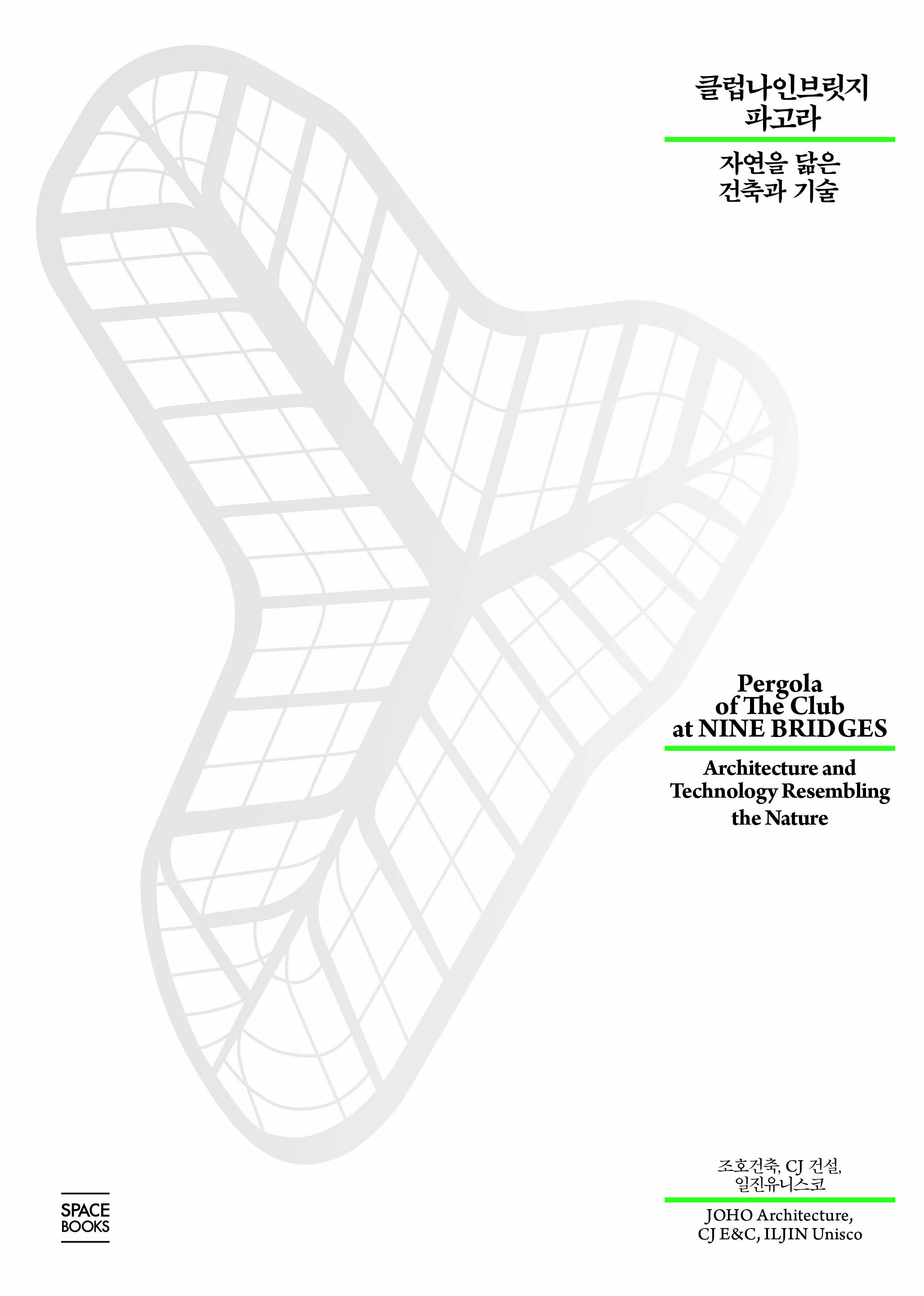
Resembling nature, embodying the nature Pergola of The Club at NINE BRIDGES
People have been inspired by
nature, searching a new rule from nature, and pursuing a life that conforms to
nature. This was naturally acquired from the past to the present, rather than
obtained from someone’s guidance. When ancient people built a house or a
building, they followed the shape or the pattern of the land, and they never cut
down a single tree recklessly. However, as population gradually increased and
technology was developed, nature was destroyed. It was no longer a life that was
in harmony with nature, whereas human began to manage and regulate nature.
Nature has evolved in the stream of development and domination, influencing
people’s lifestyle and values. Then how can we retrieve a life that is in harmony
with nature again?
『Pergola of The Club at NINE BRIDGES:
Architecture and Technology Resembling the Nature』 embodies the voices
of those people who are changing the contemporary society’s paradigm towards
nature. This book contains the architectural process and definition of the
Pergola of the Club at NINE BRIDGES. This project was initiated as a way to
preserve and restore an old tree. The Pergola of the Club at NINE BRIDGES is
located in the Club at NINE BRIDGE, Jeju Island. The architect, above all,
attempted to preserve the ecology of the 600-year-old tree. Meanwhile, he drew a
lot of inspiration from nature and was able
to complete the Pergola of the Club at NINE BRIDGES that resembles nature’s
function and shape. Its unique shape and the construction system’s advanced
technology were achieved by a collaboration of the three experts: the architect
(JOHO Architect), CM (CJ E&C), and the technician (ILJIN Unisco). Glass was used to disguise the building inside nature. Also, as
if a living organism in nature maintains its life, the building is equipped with
the system that combines structure and construction system. Overall, it marks a
new era in the architectural history.
It is a small Architecture with an architectural area of about 300㎡, but there are valuable technology and design element applied. The readers can look at the relationship between nature and architecture – the relationship based on the new perspective – and observe how glass architecture has evolved.
Exploring space where nature, technology, and history live and
breath
Most of the architectural books that have been published are humanities books
that describe perspectives towards the city and architecture, collections of
projects that focus on the achievement and activity of famous architects, and
autobiographies. Including the recorded documents that describe common building
process, they have certain biased tendencies. Among them, 『Pergola of The Club at NINE BRIDGES:
Architecture and Technology Resembling the Nature』 covers a unique
architectural process and examines the values that the Pergola of the Club at NINE
BRIDGES carry in the history of glass architecture. By rigorously exploring one
building, the architect’s design concept and his quest for new technology –
which have never been unveiled before – will be closely looked into. In
addition, it is a rare and unprecedented case in the field of architecture, that
the architect, CM, and technician who built one building together also cooperate
in compiling into one book.
The contents of the
book
In
addition to the
texts from the architect, CM, and technician, this book includes remarks from
Pippo Ciorra – the senior curator of architecture at Rome’s Museo
nazionale delle arti del XXI secolo (MAXXI museum) – and Christian FRANÇOIS – the dean of the Glass
Design Department at Ecole
Nationale Supérieure d'Architecture de Nancy
(ENSA Nancy).
First, Lee JeongHoon, the
architect who designed the Pergola of the Club at NINE BRIDGES, goes over the project
background and design meaning in the section titled ‘Connecting Nature with
Architecture’. From the moment he saw the old tree at the Club at NINE BRIDGES,
he sought to reconstruct not only the functional expansion of the club house but also
the comfort resonated from the old tree. In other words, he perceived nature as
an equal value that makes a symbiotic relationship with architectural space,
rather than a subject to conquer. Another interesting point is the perspective
that recognizes the old tree at the Pergola of the Club at NINE BRIDGES to be
similar to the symbolism that a tree located at the entrance of a Korean
village.
In the section titled ‘The
Pavilion that Breathes’, Pippo Ciorra explains the differences between
the Pergola of the Club at NINE BRIDGES and an ordinary pavilion,
and the characteristics of pavilion architecture. He recognizes that the
architect Lee JeongHoon, in fact, aims to redefine some of the specific
paradigms of pavilion architecture through the Pergola of the Club at NINE
BRIDGES. He examines this project in three aspects. One is the important
characteristics that this project carries, stability and
mobility, and the other is that the
architect used the technical and structural elements as the means to
elevate architectural quality. The last is focusing on the ‘convention’ called
pavilion or pergola when critiquing the project. Then Pippo Ciorra remarks that
“As for many other interesting architects today, Lee JeongHoon’s architecture is
not based on a recurring image but on establishing a sophisticated relationship
between place, technology, culture and the environment.”
In ‘History of Architecture with Steel and Glass’, Christian
FRANÇOIS, who teaches Glass Architecture at Ecole
Nationale Supérieure d'Architecture de Nancy (ENSA Nancy) in France, defines in which position
the Pergola of the Club at NINE BRIDGES stands in history. He
looks into the architectural history of the modern botanical garden such as
Charles Rohault de Fleury’s 1833 large metal greenhouse and Joseph Paxton’s the
Crystal Palace. As the architectural thinking that started from the 1800s reaches to the
early 20th
century, various studies on glass and the garden have been conducted in relation
to culture, industry, commerce, art, and environment. Then he brings in case studies such as the greenhouse at
Cité des Sciences et de l'Industrie, Davies Alpine House, and the
construction of Bombay Sapphire Distillery.
He said that the Pergola of the Club at NINE BRIDGES stands in continuation, in
line with these architectural studies. He explains
that in the Pergola of the Club at NINE BRIDGES, “A project that is
architecturally transparent (carried out through a process of international
industrial collaboration) there are no shortage of reminders here of the quality
realised by the glass architecture of the past.”
In the section titled
‘Architectural Structure and Innovation through Digital’, ILJIN Unisco explains the
ways to minimize errors and the precise manufacturing of construction components
when designing an irregularly shaped building. ILJIN Unisco has invested time and cost to study the method of manufacturing
precise 3D shape. It is the company that constructed buildings with unique
shapes such as DDP, CJ R&D Center, GT Tower, and the Federation of Korean
Industries in Yeouido. The structural frames of the Pergola of the Club at NINE BRIDGES follows its form and
inserted mechanical, fire protection, electrical, communication, and system
equipment to unravel the function and form into the same language. Therefore, it
required even higher methodology than the previous projects. So
ILJIN Unisco used a
software program named CATIA in the processes of design, manufacturing,
assembling each different construction components, and construction planning.
Numbering construction members and error-free manufacturing of each components
show the completion of the contemporary architectural
technology.
Professional terms such as
CATIA and MEP may feel relatively difficult for readers. However, if they go
through the texts along with the images and drawings that are included in
between, it will be an opportunity to approach the new technology a bit
easier.
CJ E&C, the company in charge of the construction, compiled the records from the year of 2016 to the completion of the construction in Jul. 2017. This description of architectural process enlightens about how much efforts and struggles had occurred even before the construction started, and how obstacles were overcome in the midst of lacking field conditions.
.jpg)





